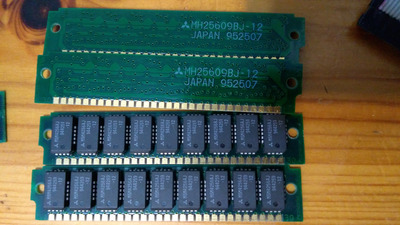Nexxen wrote on 2020-12-19, 18:00:
I have issues with 4 sticks of SIMM, post says 640KB of ram but halts and can't even get to boot memtest.
I'm not sure of what I have, as they should be 1MB sticks. 9 chips maybe is some ECC unsupported by the chipsets?
Those sticks are 256K sticks. They make up for 1MB of RAM. If your 386/486 boards support memory relocation (possibly you need to disable BIOS shadowing), the memory test should count up to 1024K, but without relocation, the 384 KB between 640K and 1024K are only usable as shadow RAM for faster ROM access or maybe as UMBs, provided proper initialization. So the BIOS counting up to 640KB might be expected behaviour.
Furthermore, you need to make sure your memtest is old enough. Newer versions of memtest try to measure memory throughput or CPU clock speed using the CPU integrated cycle-counter that didn't exist before the Pentium, so these versions crash on boot on a 486 processor. According to this thread memtest86 that works for 486 , the last version of memtest working on 486 class processors is "memtest86+ 4.10". Notice the plus, that one is a fork from the original memtest, and you need to go back even more in time to find a working non-plus memtest. And last, but not least, I am unsure whether configurations without any extended memory (so 640KB only) are supported by memtest at all...
These points add to the already mentioned fact that the access time of your modules is astonishingly slow, so you might need to add maximum wait states and maybe even underclock your mainboard to get them working properly in a 386/486 class machine at all. At least (I checked the datasheet to verify) these modules do support page-mode access, which 486-class chipsets might expect from any SIMM you plug into the mainboard.
